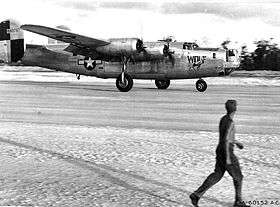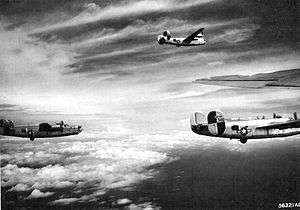867th Reconnaissance Squadron
The 867th Reconnaissance Squadron is an active United States Air Force unit. It was activated at Creech Air Force Base, Nevada on 4 June 2012 as a remotely piloted aircraft squadron.[2]
867th Reconnaissance Squadron
 | |
|---|---|
 Consolidated B-24J Liberator 44-40737 landing on Angaur Airstrip, Palau Islands | |
| Active | 1917–1918; 1940-1946; 2012-present |
| Country | |
| Branch | |
| Role | Unmanned Reconnaissance |
| Garrison/HQ | Creech Air Force Base, Nevada |
| Engagements | American Theater of World War II Pacific Theater of Operations |
| Decorations | Philippine Republic Presidential Unit Citation |
| Insignia | |
| 867th Reconnaissance Squadron Emblem (approved on 17 May 1945)[1] | |
The squadron was first active during World War I as the 92d Aero Squadron. It deployed to England in October 1917 and conducted training with the Royal Air Force, but saw no combat. It returned to the United States at the end of 1918 and was demobilized.
Activated as the 17th Reconnaissance Squadron several months before the American entry into World War II, the squadron performed in the antisubmarine campaign, while changing its designation every few months. When the United States Navy assumed full responsibility for the antisubmarine campaign in 1943, it became the 867th Bombardment Squadron and provided the cadre for a new Consolidated B-24 Liberator group. The squadron moved to the Pacific and entered combat against Japan, serving to the end of the war.
History
World War I

The squadron was first established in the summer of 1917 as the 92d Aero Squadron (Service), a World War I Air Service squadron at Kelly Field, Texas. The squadron trained with the Royal Flying Corps (later the Royal Air Force )in England, but never served in combat on the Western Front. The squadron returned to the United States in December 1918 and was demobilized.[1]
World War II
Organization and antisubmarine campaign

The 17th Reconnaissance Squadron was activated in January 1941 at Army Air Base, Savannah as a reconnaissance squadron equipped with Douglas A-20 Havocs (along with a few DB-7s, an export version of the A-20).[note 1] Its initial mission was to support Army units at Fort Stewart in maneuvers. In 17 June moved with the group to Army Air Base, Manchester, New Hampshire.[1][3]
In August 1942, the squadron was redesignated as the 92d Bombardment Squadron and assigned to the 45th Group when the Air Corps converted its reconnaissance squadrons attached to light bombardment groups to bombardment squadrons.[1] The squadron flew convoy patrols over the New England coast to the Grand Banks of Newfoundland during the summer of 1941, protecting Lend-Lease shipments of supplies and equipment to England.
_with_the_MAD_tail_boom_061128-F-1234S-023.jpg)
Following the attack on Pearl Harbor the squadron began flying antisubmarine patrols off the Atlantic coast. By the end of 1941, it began flying the Douglas B-18 Bolo, which was equipped with radar for the antisubmarine mission and, as a medium bomber unit, became the 92d Reconnaissance Squadron until April 1942, when the Army Air Forces converted its remaining reconnaissance squadrons, and it became the became the 433d Bombardment Squadron. The same month it moved to Mitchel Field, New York, as the 45th Group dispersed its squadrons for greater coverage.[2]
Although squadron headquarters was at Mitchel, detachments operated from Boca Chica Field and Miami Army Air Field, Florida and New Orleans Army Air Base, Louisiana, beginning in May 1942. The emphasis on operations in the Gulf of Mexico was demonstrated when the squadron moved to Miami Army Air Field in June.[2]
In October 1942, the Army Air Forces organized its antisubmarine forces into the single Army Air Forces Antisubmarine Command, which established the 26th Antisubmarine Wing the following month to control its forces operating over the Gulf of Mexico and the Caribbean Sea.[4][5] The command's bombardment group headquarters, including the 45th, were inactivated and the squadron, now designated the 10th Antisubmarine Squadron, was assigned directly to the 26th Wing.[2][3]
In July 1943, the AAF and Navy reached an agreement to transfer the coastal antisubmarine mission to the Navy. This mission transfer also included an exchange of AAF long-range bombers equipped for antisubmarine warfare for Navy Consolidated B-24 Liberators without such equipment.[6]
Combat in the Pacific
The squadron moved to Gowen Field, Idaho where it provided the cadre for the 494th Bombardment Group, a newly forming Consolidated B-24 Liberator heavy bomber unit as the 867th Bombardment Squadron.[1][7] Aircrews filled out the squadron in March. The air echelon began to receive new B-24Js in May and began departing for Hawaii on 28 May.[8] The ground echelon began its move to Hawaii on 1 June 1944.[7]

The squadron remained at Barking Sands Army Air Field for additional training and modifications to its planes to meet theater standards until late September 1944, when it deployed to Angaur Airstrip in the Palau Islands.[8] The squadron ground echelon was initially involved with the construction of the base on Angaur.[7] Although some unit aircrews flew combat missions with the 30th Bombardment Group from Saipan, the air echelon only began to arrive on Angaur on 24 October 1944, after the Seabees and Army engineers had prepared the airstrip for heavy bomber operations.[8] The squadron finally conducted its first mission on 3 November, when it attacked Japanese airfields on Yap and Koror. It conducted attacks on Japanese military that had been bypassed as American forces had advanced in the Central Pacific. It also attacked the Philippines, hitting gun emplacements, bivouacs, and storage depots on Corregidor and Caballo Islands at the entrance to Manila Bay. It also attacked radio communications installations and power plants at Japanese bases in the Philippines; and attacked airfields, including Clark Field on Luzon. Early in 1945, the 867th struck ammunition and supply dumps in the Davao Gulf and Illana Bay areas of Mindanao and airfields on the island.[7]
The squadron moved to Okinawa in June 1945. From its base at Yontan Airfield it engaged primarily in attacks against enemy airfields on Kyūshū and around the Inland Sea of Japan until V-J Day. It also struck airfields in China and Korea. The unit also participated in incendiary raids and dropped propaganda leaflets over urban areas of Kyūshū. After the war's end, the unit transporting personnel and supplies from Manila to Tokyo. In December, the squadron returned to the United States, where it was inactivated at the Fort Lawton Port of Embarkation on 7 January 1946.[1][7]
Unmanned aerial vehicle operations
In 2012, the squadron was redesignated the 867th Reconnaissance Squadron and reactivated at Creech Air Force Base, Nevada and assigned to the 732d Operations Group of the 432d Wing.[2]
Lineage
92d Aero Squadron
- Organized as 92d Aero Squadron on 21 August 1917
- Demobilized on 21 December 1918
- Reconstituted and consolidated with the 92d Reconnaissance Squadron in 1942[1]
867th Reconnaissance Squadron
- Constituted as the 17th Reconnaissance Squadron (Light) on 20 November 1940
- Activated on 15 January 1941
- Redesignated 92d Bombardment Squadron (Light) on 14 August 1941
- Redesignated 92d Reconnaissance Squadron (Medium) on 30 December 1941
- Consolidated with the 92d Aero Squadron in 1942
- Redesignated 433d Bombardment Squadron (Medium) on 22 April 1942
- Redesignated 10th Antisubmarine Squadron (Heavy) on 29 November 1942
- Redesignated 867th Bombardment Squadron, Heavy on 21 October 1943
- Inactivated on 4 January 1946
- Redesignated 867th Reconnaissance Squadron on 9 August 2012
- Activated on 4 June 2012[2]
Assignments
- Unknown (probably Post Headquarters, Kelly Field), 21 August–October 1917
- Attached to RAF for training, October 1917 – November 1918
- Unknown, November–21 December 1918
- 45th Bombardment Group, attached 15 January 1941, assigned 14 August 1941
- 26th Antisubmarine Wing, 22 November 1942
- 494th Bombardment Group, 1 December 1943 – 4 January 1946
- 732d Operations Group, 4 June 2012 – present[2]
Stations
|
|
Aircraft
|
World War I
|
World War II
|
Awards and Campaigns
| Award streamer | Award | Dates | Notes |
|---|---|---|---|
| Philippine Republic Presidential Unit Citation | 17 October 1944-4 July 1945 | 867th Bombardment Squadron[1] |
Manual campaign table
| Campaign Streamer | Campaign | Dates | Notes |
|---|---|---|---|
| World War I | 29 October 1917 – 11 November 1918 | 92d Aero Squadron[9] | |
| Antisubmarine | 7 December 1941-1 August 1943 | 92d Bombardment Squadron (later 92d Reconnaissance Squadron, 433d Bombardment Squadron, 10th Antisubmarine Squadron[1] | |
| Air Offensive, Japan | 30 September 1944–2 September 1945 | 867th Bombardment Squadron[1] | |
| Eastern Mandates | 30 September 1944–14 April 1944 | 867th Bombardment Squadron[1] | |
| Air Combat, Asiatic-Pacific Theater | 30 September 1944-2 March 1946 | 867th Bombardment Squadron[1] | |
| Leyte | 17 October 1944–1 July 1945 | 867th Bombardment Squadron[1] | |
| Luzon | 15 December 1944–4 July 1945 | 867th Bombardment Squadron[1] | |
| Southern Philippines | 27 February 1945–4 July 1945 | 867th Bombardment Squadron[1] | |
| Western Pacific | 17 April 1945–2 September 1945 | 867th Bombardment Squadron[1] | |
| Ryukyus | 24 June 1945–2 July 1945 | 867th Bombardment Squadron[1] | |
| China Offensive | 24 June 1945–2 September 1945 | 867th Bombardment Squadron[1] |
See also
- List of American Aero Squadrons
- Robert D. Knapp
References
Notes
- Explanatory notes
- The United States impounded 356 DB-7s ordered for France or Great Britain Baugher, Joseph (27 October 2001). "Douglas DB-73". Joe Baugher. Retrieved 1 November 2018.
- Citations
- Maurer, Combat Squadrons, pp. 789–790
- Robertson, Patsy (6 September 2013). "Factsheet 867 Reconnaissance Squadron (ACC)". Air Force Historical Research Agency. Retrieved 9 November 2016.
- Maurer, Combat Units, p. 103
- Maurer, Combat Units, p. 437
- Maurer, Combat Units, p. 389
- Ferguson, pp. 82-83
- Maurer, Combat Units, pp. 363-364
- Sestak, Ray (2002). "History of the 494th Bomb Group (H)". 494th Bomb Group (H) Association, Inc. "Kelley's Kobras". Archived from the original on 5 July 2008. Retrieved 23 January 2019.
- AF Pamphlet 900-2, 15 Jun 1971, p. 13
Bibliography
![]()
- Ferguson, Arthur B. (April 1945). "The Antisubmarine Command, USAF Historical Study No. 107" (PDF). Assistant Chief of Air Staff, Intelligence Historical Division. Retrieved 12 September 2016.
- Maurer, Maurer, ed. (1983) [1961]. Air Force Combat Units of World War II (PDF) (reprint ed.). Washington, DC: Office of Air Force History. ISBN 0-912799-02-1. LCCN 61060979.
- Maurer, Maurer, ed. (1982) [1969]. Combat Squadrons of the Air Force, World War II (PDF) (reprint ed.). Washington, DC: Office of Air Force History. ISBN 0-405-12194-6. LCCN 70605402. OCLC 72556.
- "AF Pamphlet 900-2, Unit Decorations, Awards and Campaign Participation Credits" (PDF). Washington, DC: Department of the Air Force. 15 June 1971. Retrieved 11 August 2016.
.svg.png)